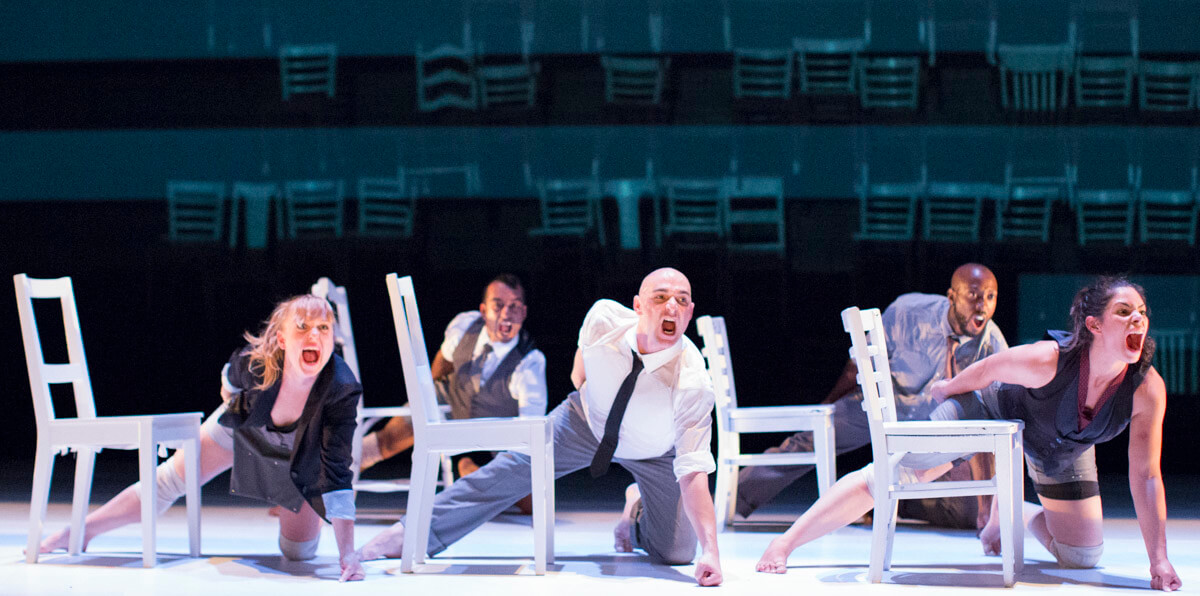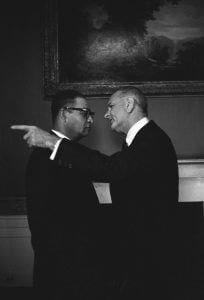How to Get Power
WHAT I BELIEVE IS ALWAYS TRUE ABOUT POWER IS THAT POWER ALWAYS REVEALS.
—Robert Caro, Lyndon Baines Johnson biographer
This essay by Michael J. Kramer was originally published by Purdue Convocations in Spring 2016.
Lyndon Baines Johnson was an imposing man. Six foot three, with a lust for domination and control that was legendary, he rose from the destitute but beautiful Hill Country region of Texas to Senate Majority Leader in 1955, to the vice presidency in 1960, and, finally, upon the assassination of John F. Kennedy in 1963, to the presidency. Johnson’s career was tainted by controversy, questionable ethics, and backroom deals that epitomized the worst of insider Washington politics and corruption. Nonetheless, when he took notice, Johnson also oversaw the passage and implementation of transformative civil rights legislation and social welfare initiatives with his Great Society programs. A man obsessed with accruing individual power, he sought to wield it in service of the collective good.
JOHNSON’S LARGER-THAN-LIFE PERSONA AND THE SWIRLING TUMULT OF THE 1960S SERVE AS THE STARTING POINT FOR THE SELDOMS’ POWER GOES.
This multimedia dance work (The Seldoms’ Power Goes / Feb. 23) is not merely a biographical study of LBJ, however. It uses Johnson to explore the concept of power and social change in American life from a much wider angle. It may seem unlikely to use dance to consider this issue, but the ways in which power and social change relate to the body, how physical movements parallel social movements, and the subtle and not-so-subtle effects of motion, stance, positioning, space, duration, performance, and interaction on public life—they all reveal dance to be one of the best forms for addressing this topic.
LBJ’s political prowess and ability to make change was itself linked to his physical presence. He famously employed the “Johnson Treatment,” leaning into other politicians when seeking to intimidate, control, or cajole them. He also knew how to stay still; according to his celebrated biographer, Robert Caro, when LBJ first came to Washington, he often sat silently in the chambers of Congress for long periods of time, taking in legislative protocols and rules.
HE WAS A MASTER OF THE TACTILE IN ALL ITS DIMENSIONS, WHETHER IN THE CLOAKROOMS OF INSIDER POLITICS OR ON THE CAMPAIGN TRAIL. INCIDENTALLY, HE ALSO LOVED TO DANCE.
Johnson was not the only one interested in power during his presidency. He was pushed to action by grassroots struggles, by civil rights freedom fighters, and others (the question of who deserves credit for the political breakthroughs of the 1960s remains contested, as demonstrated by the controversies over representations of Johnson in the film Selma). LBJ’s success in getting Congress to adopt his policies also helped to power the rise of the New Right, with its reactionary conservatism often rooted in a visceral loathing of Johnson’s Great Society programs. Far more tragically, LBJ chose to escalate American involvement in the Vietnam War, a trauma so damaging to his reputation that he did not run for reelection in 1968 even though he won his 1964 presidency by a landslide.
As Caro contends, Johnson’s story sheds light on broader questions of power. “I don’t think of my books as being biographies,” Caro explained in a 2012 interview. “My interest is in power. How power works.” It is this larger issue of power and how it works that pulsates through Power Goes.

Choreographer Carrie Hanson’s reading of Caro’s LBJ biography during 2012, an election year that saw Americans frustrated by what felt like the partisanship and stalemate of national politics in the United States, inspired the questions in Power Goes: How is power wielded for social change—or for the blockage of substantive social transformation? What is power, exactly, and how does it course through our culture, our institutions, our interactions, our belongings, our very bodies?
 At the center of Power Goes is movement. In some sections, Hanson’s dancers work against each other in duets and group pieces of opposition, manipulation, and conflict. In others, they organize into a cooperative assembly, marching in solidarity. Often, as in life, the dance mixes the two: contentiousness and concord mingle, with issues of control, intransigence, and change at stake. In all cases, the body—both individually and collectively, as a social entity—is the essential medium in Power Goes. Probing the relationship of power to persistence, hindrance, impasse, stamina, alteration, surprise, and transformation with dance allows The Seldoms to access levels of information and meaning that language cannot reach.
At the center of Power Goes is movement. In some sections, Hanson’s dancers work against each other in duets and group pieces of opposition, manipulation, and conflict. In others, they organize into a cooperative assembly, marching in solidarity. Often, as in life, the dance mixes the two: contentiousness and concord mingle, with issues of control, intransigence, and change at stake. In all cases, the body—both individually and collectively, as a social entity—is the essential medium in Power Goes. Probing the relationship of power to persistence, hindrance, impasse, stamina, alteration, surprise, and transformation with dance allows The Seldoms to access levels of information and meaning that language cannot reach.
“Put your body on the line!” That is what protesters insisted had to be done to oppose or change the policies of public figures like LBJ during the 1960s. Power Goes asks us to think about how embodiment mattered then, and continues to matter, to the workings of power. Looking back to the past to try to make sense of the present, The Seldoms put themselves on the line. They dance where history, giving us the Johnson Treatment, looms over our own time.
About the author
Michael J. Kramer is a historian, writer, critic, teacher, dramaturg, and editor. He is the author of The Republic of Rock: Music and Citizenship in the Sixties Counterculture (Oxford University Press, 2013) and is at work on a multimedia project and book about the folk music revival and technology, as well as a set of essays about intellectuals and the counterculture. He teaches history, American studies, civic engagement, and digital humanities at Northwestern University, where he is the co-founder of NUDHL, the Northwestern University Digital Humanities Laboratory. He blogs about digital topics at Issues in Digital History. He has served as dramaturg for The Seldoms and is involved with Dancing on the Third Coast: The Chicago Dance History Project. He has written for numerous publications and blogs about art, history, politics, and more at Culture Rover.
The Seldoms: Power Goes
Professor Michael J. Kramer will lead a pre- and post-show discussion for The Seldoms’ production of Power Goes, Thursday, Feb. 23 at 6:30 PM.
https://live-convocations.pantheonsite.io/event/the-seldoms/
